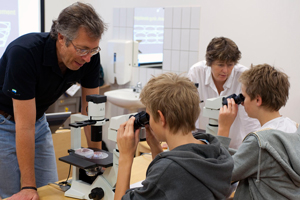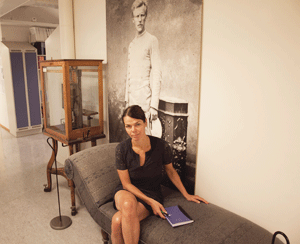We have seen the ships he used during his expeditions. We have heard the stories of his efforts on behalf of refugees in the aftermath of the First World War, and we know that he crossed Greenland on skis. Yet there is also another story. Fridtjof Nansen was not only an Arctic explorer who was awarded the Nobel Peace Prize for his humanitarian efforts; he was also a scientist and researcher.
Rapid developments after Nansen
In 1891, a revolutionary theory within brain research was proffered. This theory claimed that the brain consists of separate neurons with points of contact where signals are transmitted. Nansen contributed some of the first evidence to this theory in his 1887 doctoral thesis.
124 years after Nansen's groundbreaking scientific research, the University of Oslo houses one of the world's leading brain research communities. Here, we are firmly grounded in Nansen's spirit, and with the help of new methods and techniques our research is increasingly sophisticated.
"There has been a tremendous development over the past 10-15 years", says Professor Espen Dietrichs at the Institute of Clinical Medicine. "Neurology has a long-established reputation as a speciality in which diagnoses are made for which there are no forms of treatment. Today, we do much better, both in terms of diagnoses and in terms of treatments that alleviate symptoms."
Microscope as a central tool
A microscope was one of Fridtjof Nansen's most important tools. He used simple marine organisms to study the structure of the nervous system. Associate professor Linda Bergersen at the Institute for Basic Medical Sciences follows in his footsteps. She uses a microscope to find some of the answers she is looking for: in her research, she looks at simpler organisms than humans. Her research is based on Darwinism and faith in evolution.
Bergersen compares what takes place in skeletal muscles with what takes place in the brain. She is especially focused on energy disturbances in the brain, and asks questions about what happens in the brain when it lacks energy.
"In my research, I study proteins that were previously believed to only occur in skeletal muscles. My research shows that these proteins also occur in the blood-brain barrier and in neurons. We are also seeing that lactic acid, which is seen as waste material, can be used as energy in our brain", says Bergersen.
Epilepsy
At the moment, Bergersen is working on a temporal lobe epilepsy model. In temporal lobe epilepsy, the epilepsy originates in the hippocampus. The neurons in the hippocampus are destroyed, and the question is what the blood-brain barrier looks like when this happens.
Some epilepsy patients cannot be treated with the standard medication. In these cases, the patients are put on a ketogenic diet consisting of 80 % fat and 20 % proteins.
"This is not a particularly comfortable diet to be on, but many patients do not have epileptic episodes while on it", says Bergersen.
Physical activity leads to some of the same physiological responses in the brain as those shown during a ketogenic diet.
"We see that the ketone bodies that are produced when people are on a ketogenic diet, are transported through the blood-brain barrier by one of the proteins I study. At the same time, we know that physical activity produces lactic acid that is transported via the same proteins.
If it turns out that a ketogenic diet and physical activity have the same positive effects on epilepsy, then we can offer our patients more physical activity instead of a very strict diet."
Optical science
Professor Joel Glover at the Institute for Basic Medical Sciences heads a research group that studies brain development and optical recording. One of his areas of interests is brain and spinal cord development. Glover is particularly focused on motor systems that control how we use our muscles. The structure of the spinal cord and the connection between the brain and the spinal cord are central topics of his research.
Glover's group works on the same questions that were studied 40 years ago, but has far more advanced methods at its disposal. In particular, the group uses optical recording and stimulation.

Joel Glover teaches year 10 students in order to inspire them to become the brain researchers of the future.
Photo: Gunnar F. Lothe, UiO
Valuable mapping
"Today, we use tracers that react to calcium, which is a very important ion in nerve impulses", Glover notes. A tracer is applied to neurons, and different neurons with different functions are marked with differently coloured tracers. The mapping of the structure of the nervous system thus becomes more complete.
"We can see when the neurons are active. We mark spinal cord neurons and stimulate the brain, and the colouring helps us see whether neurons are activated in the spinal cord. We can also map ascending pathways from various systems in the brain stem, which is very central to the management of motor functions. In this way we get an overview of connections that were previously unknown", Glover explains.
To heal the lame
Joel Glover is interested in how to repair injuries to the nervous system. When suffering spinal cord injuries, patients are permanently paralysed and lose sensory functions. One of the reasons for this is the growth inhibiting molecules in the spinal cord.
"The molecules have been identified and researchers are working to find ways to dissolve these to allow growth. However, for this to be successful we must also have methods for showing that the nerve fibres find their right target cells in a reparative process. Optic recording is one of the methods we are currently using in studies of spinal cord regeneration", Glover explains.
He says that they injure the spinal cord of mice and then either encourage fibre growth or introduce stem cells to replace the lost neurons. This way, researchers can study whether regenerated fibres have found the right target cells, and whether stem cells have received their connections correctly.
Electricity as a treatment for Parkinson's disease
The clinical neuroscience research is very broad: Professor Espen Dietrichs mentions MS, strokes, pain and neurophysiology, and epilepsy as areas of research at the Institute of Clinical Medicine. He focuses on neurological movement disorders, including Parkinson's disease.
"Parkinson's disease is a neurodegenerative disease that is caused by the death of brain cells in a particular area of the brain. This is a slow process that causes shaking, trouble starting a movement and skeletomuscular stiffness.
The medicines traditionally used to treat the disease have little effect on some of the approximately 8000 patients with Parkinson's disease in Norway. Their stiffness cannot be alleviated and the shaking cannot be controlled. For these patients, a neurosurgical treatment may be an alternative."

Professor Espen Dietrichs treats patients by deep brain stimulation.
Photo: Marianne Baksjøberg, UiO
"Anually, about 40 patients are treated with deep brain stimulation. Electrodes are implanted in the brain, and these provide a high frequency, low current electric stimulation", Dietrichs says.
"At the same time, research is being done on genetic and other reasons for the neurodegenerative diseases. This research aims to stop the development of the disease. In the future, we may be able to cure these illnesses completely.
Research is ongoing on patients that are already part of an established treatment programme. The goal is to evaluate the effect of the surgical treatment."
Synapses - the important contact points
Professor Arild Njå at the Institute of Basic Medical Sciences researches synapses. These are the connection points through which signals are transmitted between cells in the nervous system. From birth, we come equipped with synapses that organise cells into circuits with different purposes.
"I am interested in how synapses change over time due to use or a lack of use", says Njå.
The synapses are plastic and change according to use. They must be refined through use in order for us to, for example, develop language and motor skills. Training is especially important following injuries to the nervous system.
Njå is especially focused on the mechanisms behind these changes, both in normal synapses and following injuries to the nervous system.
"We gain knowledge about this through experiments on animals. Neurons that die cannot normally be replaced, but the branches of an injured nerve fibre can largely be repaired. They can even develop new branches and synapses and take over the function of the injured area", says Njå.
Crucial basic research
Basic research can be crucial to approaches to training following injuries or illnesses in the nervous system. Some decades ago, research in Sweden and Denmark (and elsewhere) showed that local circuits of neurons in the spinal cord formed walking movements in animals. This led to a renewed interest in training partially paralysed patients following neck injuries.
"The results have been stellar, particularly at the Sunnaas Rehabilitation Hospital", says Njå.
Patients with spinal cord injuries now train on a treadmill while their bodies are partially held up by a strap. The initial demands are small. Though the patients at the beginning cannot walk, they can nevertheless train to walk. And following intense repetition, it turns out that the contact with the relevant neural circuits in the spinal cord often can be re-established."
Systematic Arctic exploration
Both the clinical and the experimental research that takes place in the Faculty of Medicine are of a high international standard. The Norwegian fairytale can be said to have started in 1887. Though Nansen left his research career at an unusually early stage, his research training is reflected in all his expeditions and travels.
"The systematic approach he learnt through research formed the basis for everything he did afterwards. He had a characteristically scientific approach to how he did things following his doctoral degree", Linda Bergersen notes.
The systematic approach is always part of the backdrop. It is a great example of the many sides to Nansen. Nansen took science along to the Arctic, and the rest is history.
